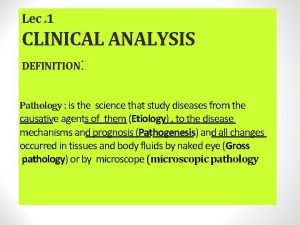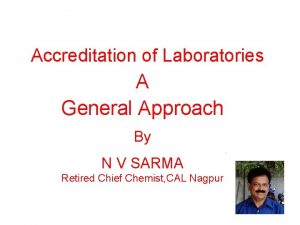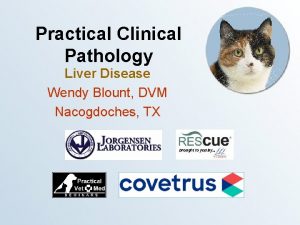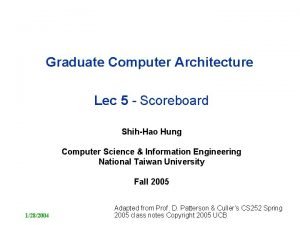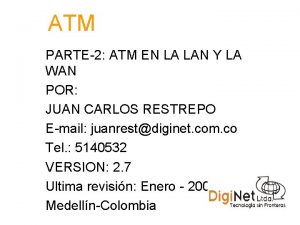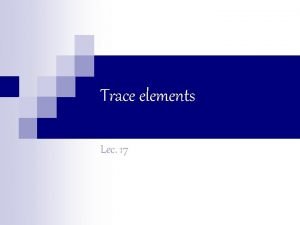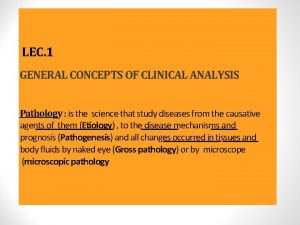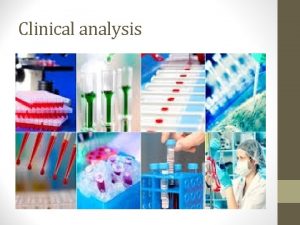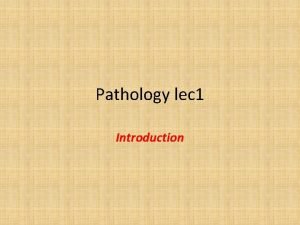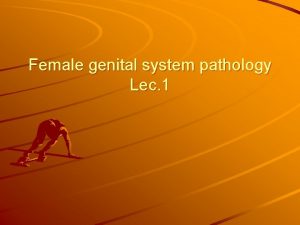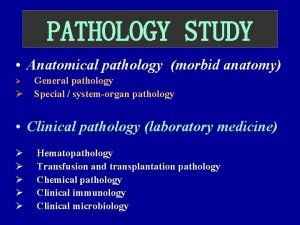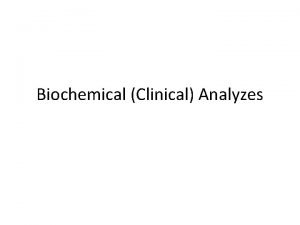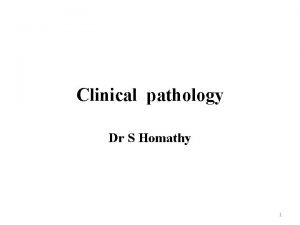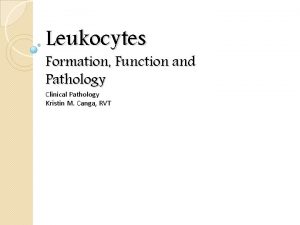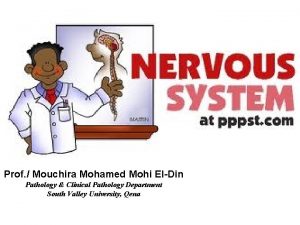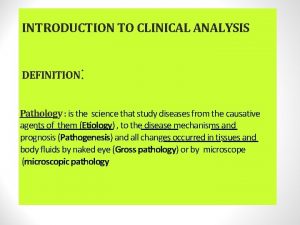Lec 1 CLINICAL ANALYSIS DEFINITION Pathology is the















- Slides: 15

Lec. 1 CLINICAL ANALYSIS DEFINITION: Pathology : is the science that study diseases from the causative agents of them (Etiology) , to the disease mechanisms and prognosis (Pathogenesis) and all changes occurred in tissues and body fluids by naked eye (Gross pathology) or by microscope (microscopic pathology

Branches of pathology include: Anatomic pathology: The study of tissues, organs, and tumors Cytopathology : The study of cellular changes and everything related to cells. Forensic pathology. Performance of autopsies and legal pathology tests. Molecular pathology. The study of DNA and RNA sequencing, genes, and genetics. Clinical analysis: is a branch of pathology that deals with the use of laboratory methods (clinical chemistry, clinical microbiology, hematology, and emerging subspecialties such as molecular diagnostics) for the diagnosis and treatment of disease

Clinical analysis

Clinical chemistry (also known as chemical pathology and clinical biochemistry): is the area of clinical pathology that is generally concerned with analysis of bodily fluids Clinical microbiology: This encompasses five different sciences (units). These include bacteriology, virology, parasitology, immunology, and mycology. Hematology: studies the blood and blood-forming tissues to evaluate presence of disease and assist in therapeutic interventions as clinically indicated.

Types of specimens used in clinical analysis Blood: is used in many tests. Blood can either be examined as a "whole, " or as plasma (the fluid left when red and white blood cells are removed), or as serum (a clear fluid that separates from blood when it clots). Blood is usually drawn with a needle from a vein, usually in the forearm. (This is also called venipuncture). Sometimes, the tip of the finger is pricked and then squeezed to draw blood (called a finger prick).


Urine: is also used for a wide range of tests. Urine specimens can be obtained by: Random method. The patient urinates in a cup. Clean catch specimen. The outer genital area has been cleaned before urinating in a cup. Sterile urine test. This requires catheterization (a tube is put into the urethra and goes to the bladder to obtain urine). Sometimes, a doctor will require the patient to do a timed test to measure substances excreted into the urine over several hours.

Sputum (also called phlegm) Sputum can be coughed into a clean container. Feces or stool is usually collected by the patient in a clean cardboard or plastic container. Other body fluids collected for testing may include the following: Spinal fluid Pleural fluids. These fluids are around the lungs and/or in the pleural cavity (the space between the two membranes that surround the lungs). Abdominal (belly) fluids Joint fluids Bone marrow

Techniques used in clinical analysis and guides in diseases diagnosis: Light microscope : used for samples examination like urine , stool, sputum , ect. Electron microscope: used for study the diseases caused by viruses or cell organells disorders Histochemistry Techniques : used for diseases caused by chemicals accumulation like Iron in tissues due to organic diseases. Immunohistochemistry Techniques : depend on Ag –Ab reaction to detect autoimmune diseases , enzymes or fluorescent dye used for this reaction and diagnosed by florescent microscope. Biochemical Technique : determine enzymes , hormones , metabolites, ions in body fluids

Light miroscope

Hematological indices Techniques: used for blood specimens Cell culture : used to study the genetic diseases by culturing patient cell in vitro in specials culture media Microbial culture : used for isolation the pathogens from different patients samples (urine , stool, blood, ect. ). Also, sensitivity testing is carried out to determine whether the pathogen is sensitive or resistant to a suggested medicine. Molecular Technique : used for study the DNA and RNA of body cells and microbes which depend on proliferation copies of genetic material by polymerase chain reaction technique (PCR)for detection cancer and other disease.

Molecular biology

Cellular injury: cell exposed to different injurious agents capable of changing the cell homeostasis and lead to change in cell appearance and function. Types of cellular injury : there are two types of cell injury: reversible (e. g. cloudy swelling ) , the accumulation of fluids , proteins, pigments , in the cell. The cell return back to its normal shape and function after removing of the injurious agents. Irreversible (permanent injury)lead to cell death by necrosis or cell apoptosis (programmed cell death). Cells differ in sensitivity to injurious agents , the most sensitive cells are the nervous system cells(3 -5 min. ) followed by cardiac and liver cell (30 -60 min. ) other cells need several hours to effect by injurious agents.

Types of injurious agents 1 -Hypoxia: cell oxygen deficiency because of -low in blood supply to cells (ischemia) due to narrowing arterioles as in atherosclerosis and thrombi. -low in blood oxygenation due to heart failure or respiratory failure. -low in RBCs ability in carrying oxygen as in Anemia. 2 -Physical agents : like trauma , wounds , fractions, heat , cold, radiation (x-ray, gamma ray , UV) 3 -Chemical agents: likes acids, bases, pollutions , toxins, Alcohols , narcotic drugs. 4 -Infectious agents : like bacteria , viruses, fungi, parasites. 5 - Immunological agents: like hypersensitivity and autoimmune diseases. 6 -Genetic agents : disorder in chromosomes numbers as in downs syndrome or in genes component as in sickle cell anemia. 7 -Nutritional agents: include nutrient deficiency as in vitamin deficiency or nutrition excess as in obesity.

Th an ks
 Definition of clinical pathology
Definition of clinical pathology Nabl assessor course
Nabl assessor course Clinical pathology accreditation
Clinical pathology accreditation Clinical pathology accreditation
Clinical pathology accreditation Clinical pathology accreditation
Clinical pathology accreditation Normal alt in cats
Normal alt in cats Lec scoreboard
Lec scoreboard 11th chemistry thermodynamics lec 13
11th chemistry thermodynamics lec 13 Lec ditto
Lec ditto Lec scoreboard
Lec scoreboard Componentes del lec
Componentes del lec 11th chemistry thermodynamics lec 10
11th chemistry thermodynamics lec 10 Biochemistry
Biochemistry August lec 250
August lec 250 Lec 16
Lec 16 Lec material
Lec material
